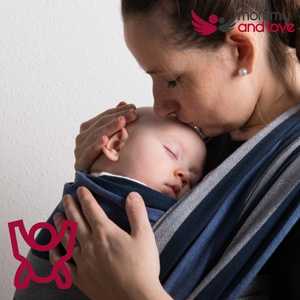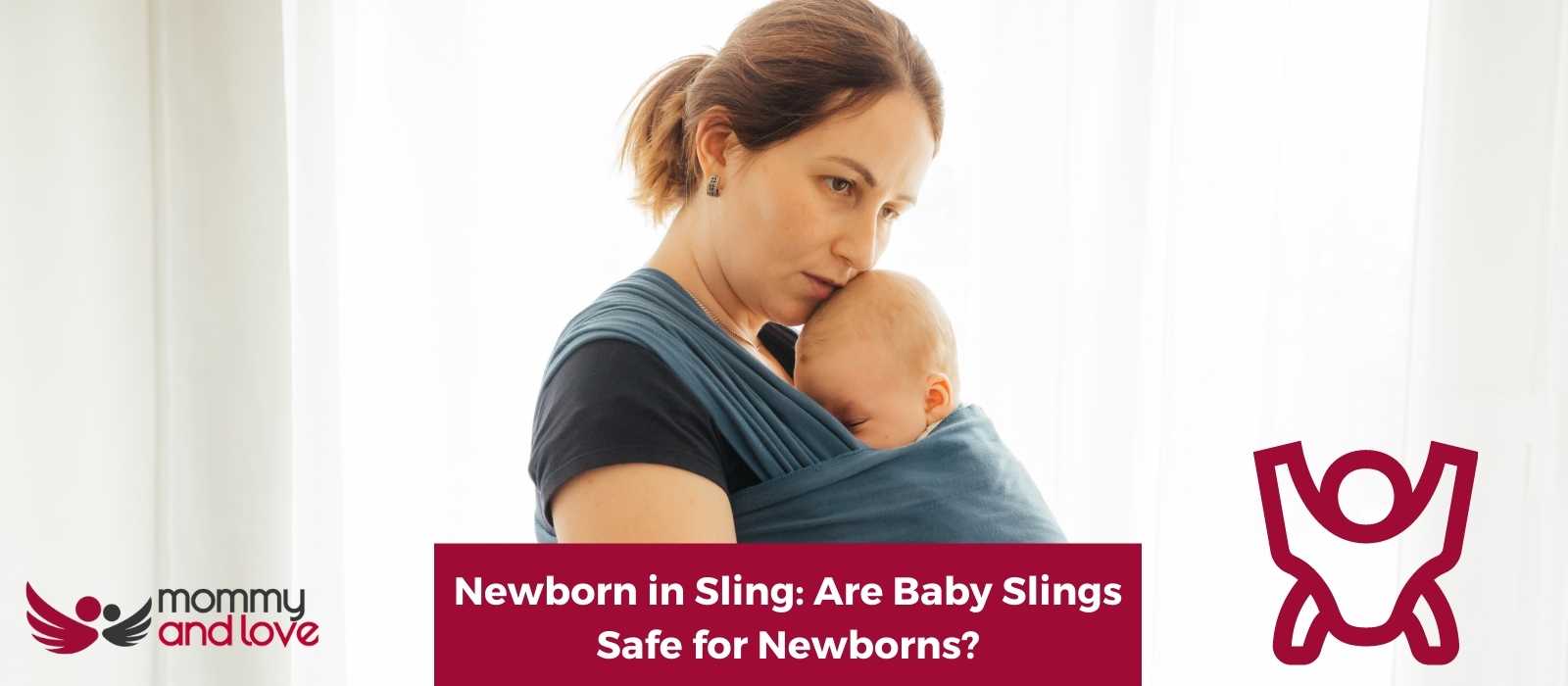When it comes to keeping your baby safe, you want to make sure that you are using the safest products possible. There is a lot of debate surrounding the use of baby slings, and some people believe that they are not safe for young babies.
If you follow the safety standards and guidelines, a baby sling, which is often a one-shouldered baby carrier made of soft fabric, is a safe and comfortable way to carry a newborn baby. However, a baby sling can cause suffocation and asphyxia in a baby, especially those under the age of four months if you don’t follow the safety guidelines.
When Can You Start Wearing Your Baby in a Sling?
Most newborn baby slings and woven wraps can be used from birth for babies weighing at least 8lbs. However, take extra caution or talk to your pediatrician or a sling consultant before using a baby sling or baby carrier if your baby is or has the following:
- Premature babies
- Low birth weight
- Has a respiratory problem such as cold
How to Use a Baby Sling Safely
It is absolutely important that you follow the TICKS guidelines or the HANDS guidelines for safe sling use.

Here are some tips on how to use a baby sling safely:
- Make sure that the sling is tight enough so that your baby cannot wiggle out of it.
- Support your baby’s head and neck at all times.
- The baby should be positioned high and in an upright position with head support so that they can breathe easily.
- Your baby should be close enough to your chin that if you tilt their head forward, you can easily kiss their head. The baby’s body is angled to the opposite side and crosses the wearer’s abdomen.
Hands Baby Carrier Safety Guidelines
The Hands Baby Carrier guidelines were developed by Maebh Collins, the owner of Baba me and one of the most experienced sling consultants in the world, being both Trageschule trained to Certified level (the most advanced) and Slingababy consultant trained. The Hands guidelines are more rounded than the ticks as they cover both airway safety and hip healthy carrying.
With HANDS guidelines, always make sure that when you are carrying the baby you can do so handsfree and the baby still feels secure. This means you don’t feel the need to keep hold of the baby, this way you know the sling is on correctly.
Always monitor your babies airways to ensure they are clear and never covered with fabric, or slumped into their chest.
Make sure the carrier you have the fabric goes from one knee joint to the other knee joint, thus giving optimal support for your baby ensuring they are being carried in a hip healthy way.
The sling should also ensure that the baby is sitting in a nice deep seat, again to ensure they are hip healthy.
Lastly, the sling should be tight and give plenty of support to the back and neck of your baby.
Practice makes perfect. If you’re a first-time user of a baby sling, you may want to practice using the sling with a doll or teddy bear as a stand-in for your new baby. However, be cautious when watching Youtube videos since they are mostly not made by professionals.
By following these simple tips on how to properly carry your baby, you can keep your baby safe and comfortable while using ring slings.
What Are the Benefits of Using a Sling?
Carrying babies in baby carriers and slings can provide many benefits for both you and your baby.
Here are just a few of the benefits of using a ring sling:
- Convenient – A ring sling can be very convenient. You can wear it while you are doing other things, such as cooking or cleaning. It leaves your hands free and more freedom to do other chores in the house.
- Comfortable – Slings are also very comfortable for both you and your baby. They distribute the weight of your baby evenly, which can help to prevent back pain.
- Bonding – One of the best benefits of using a sling is the bonding that it can promote between you and your baby. When you are holding your baby close to your body, they can feel your heartbeat and your warmth. This can help to create a strong bond between you and your baby.
- Baby’s Development – It is important to balance the amount of time your baby spends in a baby carrier or sling with plenty of time on their tummy and getting other types of exercise and physical activity.
If you are thinking about using a sling, be sure to do some research to find the right one for you and your baby from different styles and sling libraries.
What Are the Risks of Using Baby Slings?

There are a few risks associated with using baby slings, the most serious of which is suffocation.
If the baby is not positioned correctly in the sling, your baby’s position can easily slip down into a position where their nose and mouth are covered by fabric, blocking their airway.
Another risk to be aware of is that baby slings can increase the risk of hip dysplasia. This is because the baby’s hips are not supported in a natural position, and over time this can lead to the development of hip dysplasia. This is also the reason why your baby’s legs should not be straight while in the sling, they should always be in a deep seat.
Finally, baby slings can also be a tripping hazard. If you are not careful when using a baby sling, you could easily trip and fall, which could injure both you and your baby.
Can a Baby Sleep in a Baby Sling?
Sleeping upright in a well-fitting and supportive sling is actually quite safe for your baby as long as you follow some important guidelines.
Here’s what you need to know about safely using a baby sling for sleep:
- Make sure that the ring sling is well-fitting and supportive. The fabric should be tight enough to hold your baby close, but not so tight that it restricts their breathing.
- The sling should also be positioned so that your baby’s head is higher than their bottom, and the baby’s chin is not resting on their chest.
- If you’re using a woven wrap, make sure that it is tied securely in a double hammock carry. This will help to keep your baby securely in place while they sleep.
- Carry or wear your baby high on your chest to monitor her breathing.
Once you have the sling positioned correctly, it’s time to put your baby in it. Gently lower them into the sling, making sure that their head and neck are supported. You may need to adjust the fabric once your baby is in the sling to make sure that they are comfortable and securely in place.
Once your baby is in the sling, you can put them to sleep just like you would in a crib or bassinet. Just make sure to keep an eye on them and check on them regularly to make sure that they are still positioned safely in the sling.
According to Babywearing International, do can allow your infant to sleep in a sling on a regular basis, in fact studies have shown that the risks of SIDS is reduced in a sling.
Can Babies Suffocate in a Sling?

Breathing could be obstructed if a baby’s face, including nose and mouth, is pressed against their parent’s body. Suffocation or asphyxiation can occur within minutes and could lead to death.
Most babies can suffocate in a sling if they are not positioned correctly. The baby’s face and head should be up and facing the caregiver, and the chin should be off the chest.
The baby should also be able to see the caregiver’s face. If the baby is not positioned correctly in the cradle carry or pouch, he or she may struggle to breathe and could eventually suffocate.
If you or other carers are using a sling, it is important to read the instructions carefully and to follow them closely. If you have any questions or concerns, please consult a qualified babywearing expert. Do not use a sling if you are not confident in your ability to use it safely.
Babies have died while being carried in slings, so it is important to be aware of the risks and to take precautions.
How Can I Keep My Baby Safe in Their Sling or Carrier?
Here are a few tips to help keep your child safe while they’re in their sling or carrier:
- Make sure that the sling or carrier is properly positioned on your body before putting your baby in it.
- Be aware of your baby’s positioning and make sure that they’re not in an awkward or uncomfortable position to prevent suffocation.
- Your baby should be facing upwards in a cradle position or cradle hold, not turned in towards your body.
- If you’re using a cradle carry or a pouch, make sure your baby’s bottom is in the deepest area of the sling.
- Make sure that your baby is securely fastened in the sling or carrier.
- The pelvic tuck into an M shape with knees higher than the bottom will support baby’s back while also being incredibly comfy. Spread squat or M position is considered more stable and less likely to fold up or slouch.
- Be careful not to put too much pressure on your baby’s head or neck while they’re in the sling or carrier.
- Avoid using a sling or carrier if your child has any medical conditions that could be aggravated by it.
- Frequently check your baby’s face is visible at all times. Since babies don’t yet have good head control, you can use the top rail of the sling to hold their head against your chest.
- In hot weather, avoid using carriers because your body heat and the carrier will raise your baby’s temperature.
- Hip carry is recommended for older babies who can already control their heads and neck.
- Never wear or carry your baby if you’re handling hot food or liquids.
- To keep the child from slouching, the upper body should be propped up against the parent’s chest.
- Make sure there is no loose fabric that can hinder the breathing of your child.
How Long Can You Carry Baby in a Sling?
Assuming you’re referring to babywearing in general, there is no time limit! You can wear your baby as long as you’d like. That said, it is important to be aware of the potential risks of wearing your baby for long periods of time.
Take Away on Carrying Babies in a Sling
So, are baby slings safe for newborns? The answer is absolutely yes as long as you follow the HANDS guidelines.
Slings can be a great way for many parents to carry their baby, but it’s important that you follow the safety recommendations to avoid any potential risks.
Make sure the sling isn’t too tight and position your baby so their chin is clear of fabric. If you have any questions or concerns, consult with your sling consultant.

This article was written by Sandra Baker – full time writer and the mother of four amazing kids (including twins!)
She’s also a breastfeeding counselor and has spent years helping new parents learn how to care for their children. When she’s not writing or caring for her children, Sandra likes to spend time reading and taking walks with her husband.




